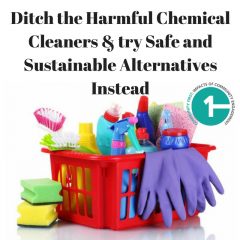by Carly Foubert, CFICE Communications RA
Cleaning products contain a considerable amount of chemicals. Chemicals that are poisonous and dangerous to consume or come in contact with your skin. Chemicals such as bleach, ammonia, and phosphates. Chemicals that are now all over your home.
Environmental experts say that the average household contains approximately 62 toxic chemicals. In the year 2000, cleaning products were responsible for nearly 10% of all toxic exposures reported in the U.S. to Poison Control Centre, accounting for 206 636 calls.
Canadians spend around $275 million on cleaning products a year, with the expectation and intention that they will fight germs and make our homes a safer place. While this is largely true, there are considerable risks to using chemical cleaners and there are certainly safer alternatives.
Microfleece towels are an effective sustainable method of cleaning. The structure of the microfiber allows them to be more effective at trapping dirt and dust particles than cotton paper towels, saving paper as microfleece towels are reusable and multipurpose.

©Adam’s Polishes
Due to the microfibers of the cloth, they are more effective at picking up dirt if they are dry when used or with water. Soap actually reduces the microfleece effectiveness. Therefore cleaning with microfleece reduced the amount of chemicals you use to clean and in your home.
There are also many ingredients in your kitchen that can be used to make environmentally sustainable cleaning products, which will also be more cost effective. Vinegar, baking soda, and essential oils are popular DIY (do-it-yourself) cleaning product ingredients as alternatives to purchasing chemical cleaners.